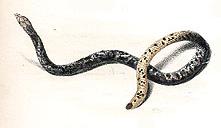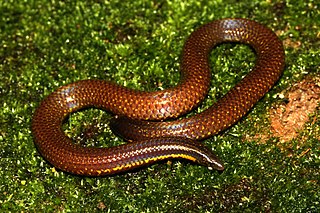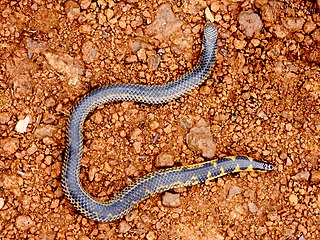Platyplectrurus trilineatus, commonly known as the Tri-striped shieldtail snake or the lined thorntail snake, is a species of uropeltid snake endemic to the Western Ghats of Southern India. Like most other shieldtail snakes, it is presumed to be a nocturnal, fossorial snake inhabiting evergreen forests. A very rare snake, about which nothing is known in terms of live colouration and natural history.

Rhinophis sanguineus, commonly known as the salty earth snake, is a species of uropeltid snake found in the Western Ghats of India.
Uropeltis beddomii, commonly known as Beddome's earth snake, is a species of snake in the family Uropeltidae. The species is endemic to India.
Uropeltis broughami, commonly known as Brougham's earth snake or the Sirumalai shieldtail, is a species of snake in the family Uropeltidae. The species is endemic to the Western Ghats in southern India.
Uropeltis dindigalensis, commonly known as the Dindigul uropeltis and the Sirumalai Hills earth snake, is a species of snake in the family Uropeltidae. The species is endemic to Sirumalai and surrounding hill ranges of the southern Eastern Ghats, in Dindigul district of Tamil Nadu state in South India.

Uropeltis ellioti, commonly known as Elliot's earth snake and Elliot's shieldtail, is a species of snake in the family Uropeltidae. The species is endemic to India.

Uropeltis macrolepis, commonly known as the Bombay earth snake, the Bombay shieldtail, and the large-scaled shieldtail, is a species of snake in the family Uropeltidae. The species is endemic to southern India. There are two recognized subspecies.
Uropeltis macrorhyncha is a nonvenomous shield tail snake species endemic to India. No subspecies are currently recognized.

Uropeltis maculata is a nonvenomous shield tail snake species endemic to southern India. No subspecies are currently recognized. Its common name is spotted earth snake.
Uropeltis nitida is a species of nonvenomous shield tail snake. It is endemic to southern India. No subspecies are currently recognized.
Uropeltis ocellata is a non-venomous shield tail snake species found in southern India.

Uropeltis phipsonii, commonly known as Phipson's shieldtail, is a species of snake in the family Uropeltidae. The species is endemic to India.

Uropeltis pulneyensis, commonly known as the Palni shieldtail, is a species of uropeltid snake endemic to the Western Ghats of India.
Uropeltis rubrolineata is a nonvenomous shield tail snake species endemic to southern India. No subspecies are currently recognized.

Uropeltis rubromaculata is a nonvenomous shield tail snake species endemic to southern India. No subspecies are currently recognized.
Smith's earth snake, also known commonly as the violet shieldtail, is a species of nonvenomous snake in the family Uropeltidae. The species is endemic to India.
Uropeltis is a genus of nonvenomous shield tail snakes endemic to peninsular India. As of 2022, 26 species are recognized as being valid.

Rhinophis is a genus of nonvenomous shield tail snakes found in Sri Lanka and South India. Currently, 24 species are recognized in this genus. Of the 24 species, 18 are endemic to Sri Lanka, while 6 are endemic to South India.

Uropeltis shorttii, also known as the Shevaroy Hills earth snake or Shortt's shieldtail snake, is a species of non-venomous snake endemic to the Southern Eastern Ghats of India. This species was first described as Silybura shorttii by Richard Henry Beddome, in 1863. It is found only in the Shevaroy Hills of Salem district in Tamil Nadu state in South India. This species was misclassified into Uropeltis ceylanica, a snake endemic to the Western Ghats, for a long time, till a recent taxonomic study proved it to be a distinct species with a very narrow geographic range. It is a burrowing snake, presumed to be nocturnal; feeding on soft-bodied worms. Becomes active during the rains. Shevaroy HilIs Earth Snake has most recently been assessed for The IUCN Red List of Threatened Species in 2019. Uropeltis shorttii is listed as Critically Endangered under criteria B1ab(iii).

Uropeltis madurensis, the Madurai shieldtail, is a small, fossorial, non venomous, snake of the family Uropeltidae, endemic to the Western Ghats of South India.










